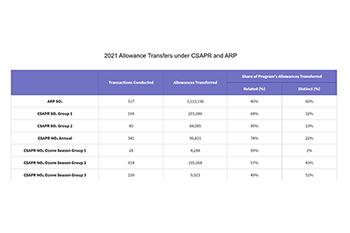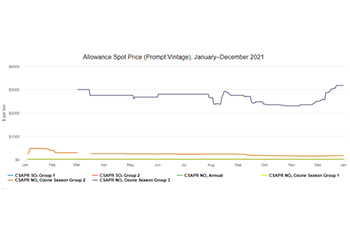Progress Report
Market Activity
Market Activity Figures
Last updated: 07/2022
Related Figures


Highlights
Transaction Types and Volumes
- In 2021, more than 550,000 allowances were traded across all six of the CSAPR trading programs.
- Thirty-six percent of the transactions within the CSAPR programs were between distinct organizations.
- In 2021, over 3 million ARP allowances were traded.
- Twenty-six percent of the transactions within the ARP were between distinct organizations.
2021 Allowance Prices1
- The ARP SO₂ allowance prices averaged less than $1 per ton in 2021.
- The CSAPR SO₂ Group 1 allowance prices started and ended 2021 at $1.56 per ton.
- The CSAPR SO₂ Group 2 allowance prices started and ended 2021 at $2.31 per ton.
- The CSAPR NOₓ annual program allowances started 2021 at $2.00 per ton and ended 2021 at $2.50 per ton.
- The CSAPR NOₓ ozone season Group 1 program allowances started 2021 at $2.00 per ton and ended 2021 at $2.50 per ton.
- The CSAPR NOₓ ozone season Group 2 program allowances started 2021 at $200 per ton and ended 2021 at $166 per ton.2
- The CSAPR NOₓ ozone season Group 3 program allowances started in March, 2021 at $3,000 per ton and ended 2021 at $3,175 per ton.3
- Allowance prices as reported by S&P Global Market Intelligence, 2022.
- The CSAPR NOₓ Ozone Season Group 2 program was established by the CSAPR Update in October 2016. The program originally covered 22 states, and currently covers 10 states, including Alabama, Arkansas, Iowa, Kansas, Mississippi, Missouri, Oklahoma, Tennessee, Texas, and Wisconsin.
- The CSAPR NOₓ Ozone Season Group 3 program was established under the Revised CSAPR Update in April 2021 and covers 12 states, including Illinois, Indiana, Kentucky, Louisiana, Maryland, Michigan, New Jersey, New York, Ohio, Pennsylvania, Virginia, and West Virginia.
Background Information
Transaction Types
Allowance transfers are the movement of allowances between allowance holding accounts. There are generally two types of transfers, those initiated by the EPA and private transactions. EPA transfers to accounts include the initial allocation of allowances by states or EPA, as well as transfers into accounts related to set-asides. Private transactions include all transfers initiated by authorized account representatives for any compliance or general account purposes. The market activity analysis is based on private transactions.
To better understand the trends in market performance and transfer history, EPA classifies private transfers of allowance transactions into two categories:
- Transfers between separate and unrelated parties (distinct organizations), which may include companies with contractual relationships (such as power purchase agreements) but excludes parent-subsidiary types of relationships.
- Transfers within a company or between related entities (e.g., holding company transfers between a facility compliance account and any account held by a company with an ownership interest in the facility).
While all transactions are important to proper market operation, EPA follows trends in transactions between distinct economic entities with particular interest. These transactions represent an actual exchange of assets between unaffiliated participants, which reflect companies making the most of the cost-minimizing flexibility of emission trading programs. Companies accomplish this by finding the cheapest emission reductions not only among their own generating assets, but across the entire marketplace of power generators.
Allowance Markets
The 2021 emissions were below emission budgets for the ARP and for all six CSAPR programs. As a result, the allowance prices for most of the CSAPR programs were well below the marginal cost for reductions projected at the time of the final rule, and are subject, in part, to downward pressure from the available banks of allowances.